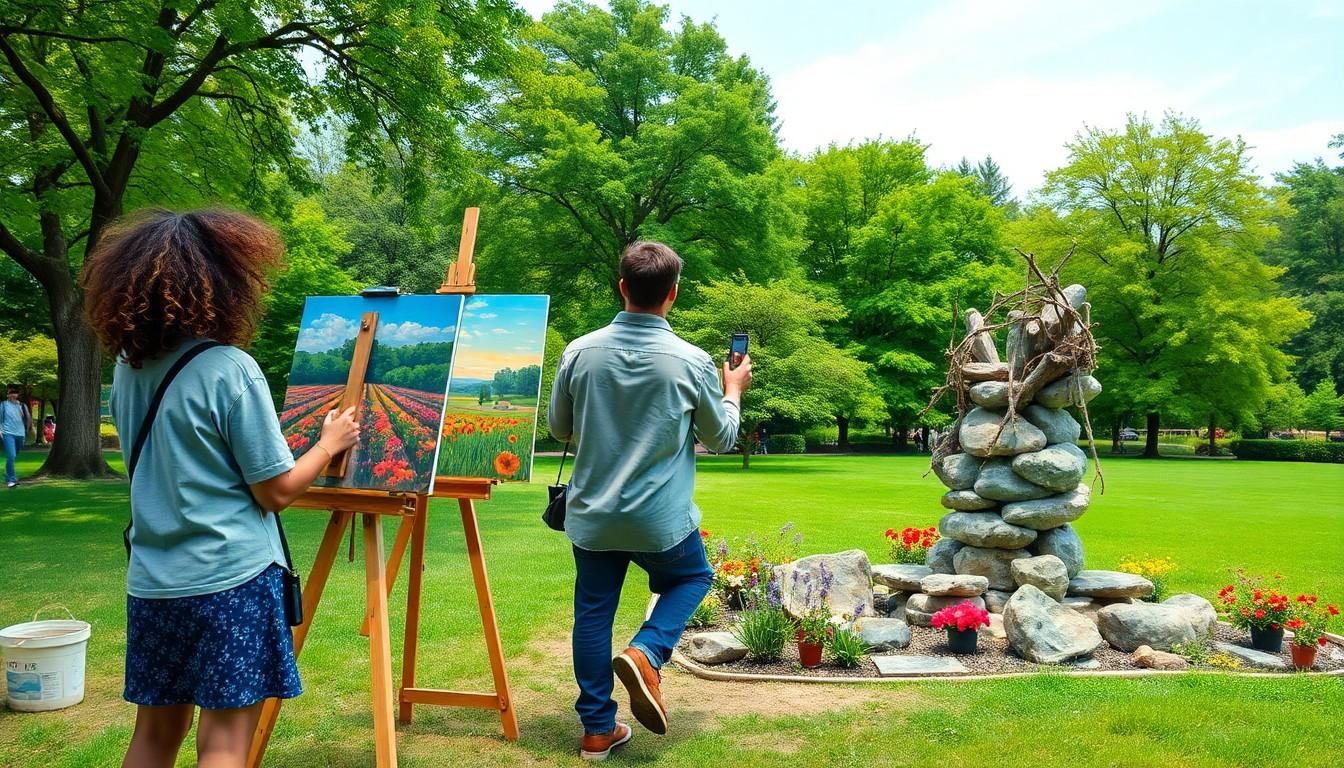Imagine a world where creativity meets fresh air, and paintbrushes dance in the sunlight. Outdoor art activities offer the perfect escape from the mundane, allowing anyone to unleash their inner Picasso while soaking up nature’s beauty. Whether it’s splattering paint on a canvas or sculpting a masterpiece from clay, the great outdoors provides an inspiring backdrop that indoor studios just can’t compete with.
Table of Contents
ToggleBenefits of Outdoor Art Activities
Outdoor art activities offer numerous benefits that extend beyond creativity. Engaging in art outdoors promotes a deeper connection to nature while enhancing the creative process.
Enhancing Creativity
Artistic expression flourishes in outdoor settings thanks to the vibrant environment. Natural light stimulates inspiration and can boost productivity. Different elements, such as trees, water, and wildlife, provide unique visual stimuli that enrich artistic ideas. Outdoor spaces encourage experimentation with various materials and techniques, allowing artists to break free from conventional boundaries. Group activities in nature foster collaboration, which also enhances creativity.
Improving Mental Health
Mental health improvements stem directly from outdoor art activities. Nature exposure reduces stress levels and promotes relaxation. Engaging in creative tasks in open spaces aids in focusing the mind, leading to feelings of tranquility. Studies show that artistic endeavors can lead to improved mood and lower anxiety. Furthermore, the physical aspect of working outdoors contributes to overall well-being, enhancing both physical and mental health simultaneously.
Popular Outdoor Art Activities
Engaging in outdoor art activities enriches the creative process and deepens connections with nature. Popular options include painting in serene settings and creating sculptures with natural materials.
Painting in Nature
Painting in nature offers artists a vibrant and dynamic environment. Using watercolors, acrylics, or oils allows for capturing the beauty of landscapes. Artists often set up easels in parks, gardens, or along trails. Natural light enhances colors, inspiring creativity and experimentation. Plein air painting, an approach where the artist paints outdoors, promotes direct observation of surroundings. Painters frequently find that the sounds and sights of nature stimulate their artistic expression.
Sculpture and Nature Materials
Sculpture using nature materials invites unique artistic exploration. Various elements, such as stones, leaves, and branches, serve as sources for sculptors. Artists create installations that blend art with the environment. Creativity thrives in exploring textures and forms of found objects. Individuals often gather materials during nature walks, transforming them into sculptures that reflect their surroundings. This practice not only promotes environmental awareness but also encourages collaborative projects among artists.
Tips for Organizing Outdoor Art Activities
Organizing outdoor art activities requires careful planning and consideration to ensure a rewarding experience. Here are key tips to enhance the outdoor creative process.
Choosing the Right Location
Choosing an appropriate location significantly impacts the success of outdoor art activities. Select a place surrounded by natural beauty, such as parks, gardens, or beaches, to inspire creativity. Consider accessibility for participants and ensure there’s adequate space for setup. Quiet environments with minimal distractions foster focus and inspiration. Ensure available amenities, such as tables, seating, and restroom facilities, enhance the overall experience. Factor in light conditions at different times of day, as natural light enhances color perception and artistic expression.
Gathering Supplies
Gathering supplies in advance streamlines the process on the day of the activity. Create a comprehensive list, including essential items like canvases, paints, brushes, and palettes for painting. If sculpting, collect materials such as clay, sticks, and other natural elements. Pack drop cloths or newspapers to protect the surrounding area. Ensure availability of water and snacks to keep participants refreshed and energized. Always consider the number of participants when estimating supply quantities, allowing enough for the group to engage fully in the creative experience.
Incorporating Outdoor Art Activities in Education
Integrating outdoor art activities into educational settings enhances student engagement. Students experience hands-on learning through practical art projects in nature. Creative expression becomes more vibrant when students paint or sculpt using their surroundings as inspiration.
Utilizing natural environments fosters collaboration. Group projects encourage teamwork, improving communication skills among students. Students learn to share ideas and techniques, enhancing their overall artistic abilities.
Administrators should consider various outdoor venues for art activities. Parks, community gardens, and schoolyards provide diverse backdrops, inspiring creativity. Each location offers unique elements, enriching the learning process.
Curating supplies in advance is essential. Art instructors should prepare necessary materials, ensuring a smooth workflow during outdoor sessions. Items like easels, paints, and tools specific for outdoor sculpting create an effective artistic environment.
Incorporating reflection time enhances the educational experience. Allowing students to discuss their creations fosters critical thinking. Reflective practices enable them to assess their work while appreciating their connection to nature.
Planning for diverse learner needs is crucial. Differentiation ensures all students can engage meaningfully, regardless of skill level. Educators should adapt activities to accommodate varying artistic abilities.
Assessing the impact of outdoor art activities promotes continuous improvement. Gathering feedback from participants helps educators refine future sessions. Monitoring student progress reveals the benefits of outdoor learning on artistic development.
Implementing outdoor art activities enriches the curriculum. Students gain a deeper appreciation for nature while developing artistic skills. Education becomes more dynamic and engaging through these creative experiences.
Conclusion
Outdoor art activities offer a unique blend of creativity and nature that enriches the artistic experience. By stepping outside, individuals not only enhance their connection to the environment but also unlock new levels of inspiration and expression. The benefits extend beyond creativity to include improved mental health and well-being, making these activities a valuable addition to anyone’s routine.
Whether it’s painting landscapes or sculpting with natural materials, the possibilities are endless. Organizing these activities with thoughtful planning ensures a rewarding experience for participants. Embracing outdoor art can transform how individuals engage with both their creativity and the world around them, fostering a deeper appreciation for nature and artistic expression.





